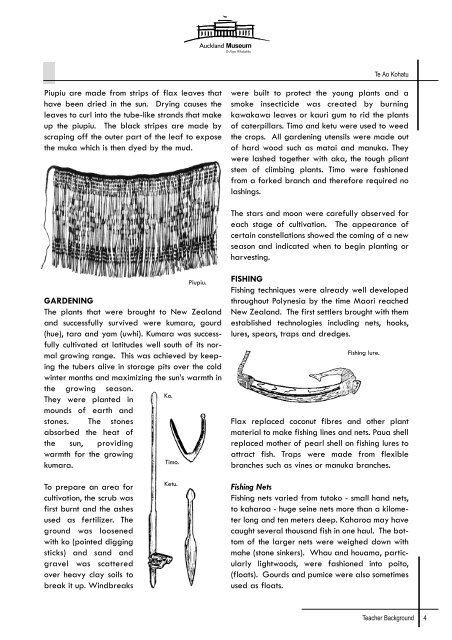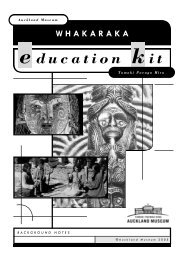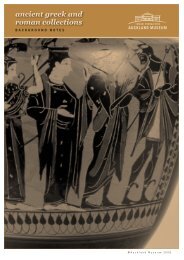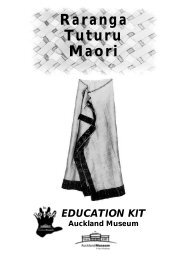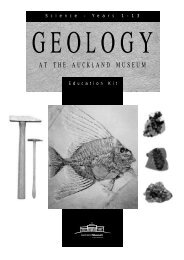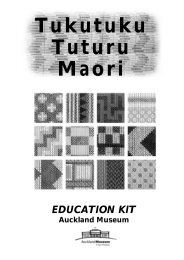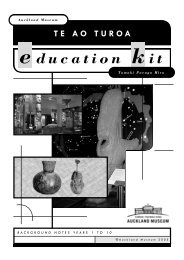Create successful ePaper yourself
Turn your PDF publications into a flip-book with our unique Google optimized e-Paper software.
Piupiu are made from strips of flax leaves that<br />
have been dried in the sun. Drying causes the<br />
leaves to curl into the tube-like strands that make<br />
up the piupiu. The black stripes are made by<br />
scraping off the outer part of the leaf to expose<br />
the muka which is then dyed by the mud.<br />
GARDENING<br />
The plants that were brought to New Zealand<br />
and successfully survived were kumara, gourd<br />
(hue), taro and yam (uwhi). Kumara was successfully<br />
cultivated at latitudes well south of its normal<br />
growing range. This was achieved by keeping<br />
the tubers alive in storage pits over the cold<br />
winter months and maximizing the sun’s warmth in<br />
the growing season.<br />
They were planted in<br />
mounds of earth and<br />
Ko.<br />
stones. The stones<br />
absorbed the heat of<br />
the sun, providing<br />
warmth for the growing<br />
kumara.<br />
Timo.<br />
To prepare an area for<br />
cultivation, the scrub was<br />
first burnt and the ashes<br />
used as fertilizer. The<br />
ground was loosened<br />
with ko (pointed digging<br />
sticks) and sand and<br />
gravel was scattered<br />
over heavy clay soils to<br />
break it up. Windbreaks<br />
Ketu.<br />
Piupiu.<br />
<strong>Auckland</strong> <strong>Museum</strong><br />
Te Papa Whakahiku<br />
Te Ao Kohatu<br />
were built to protect the young plants and a<br />
smoke insecticide was created by burning<br />
kawakawa leaves or kauri gum to rid the plants<br />
of caterpillars. Timo and ketu were used to weed<br />
the crops. All gardening utensils were made out<br />
of hard wood such as matai and manuka. They<br />
were lashed together with aka, the tough pliant<br />
stem of climbing plants. Timo were fashioned<br />
from a forked branch and therefore required no<br />
lashings.<br />
The stars and moon were carefully observed for<br />
each stage of cultivation. The appearance of<br />
certain constellations showed the coming of a new<br />
season and indicated when to begin planting or<br />
harvesting.<br />
FISHING<br />
Fishing techniques were already well developed<br />
throughout Polynesia by the time Maori reached<br />
New Zealand. The first settlers brought with them<br />
established technologies including nets, hooks,<br />
lures, spears, traps and dredges.<br />
Fishing lure.<br />
Flax replaced coconut fibres and other plant<br />
material to make fishing lines and nets. Paua shell<br />
replaced mother of pearl shell on fishing lures to<br />
attract fish. Traps were made from flexible<br />
branches such as vines or manuka branches.<br />
Fishing Nets<br />
Fishing nets varied from tutoko - small hand nets,<br />
to kaharoa - huge seine nets more than a kilometer<br />
long and ten meters deep. Kaharoa may have<br />
caught several thousand fish in one haul. The bottom<br />
of the larger nets were weighed down with<br />
mahe (stone sinkers). Whau and houama, particularly<br />
lightwoods, were fashioned into poito,<br />
(floats). Gourds and pumice were also sometimes<br />
used as floats.<br />
Teacher Background<br />
4


